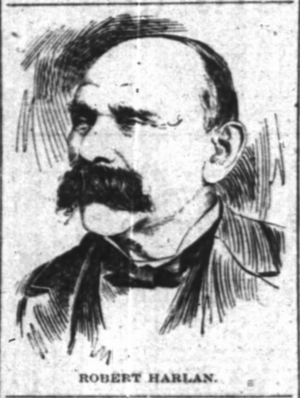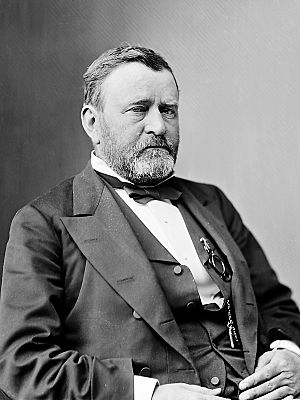Robert James Harlan facts for kids
Quick facts for kids
Robert James Harlan
|
|
|---|---|

Sketch from The Cincinnati Enquirer, September 22, 1897
|
|
| Member of the Ohio House of Representatives from Hamilton County |
|
| In office March 26, 1886 – 1887 |
|
| Preceded by | Multi-member district |
| Succeeded by | Multi-member district |
| Personal details | |
| Born | December 12, 1816 Mecklenburg County, Virginia, U.S. |
| Died | September 21, 1897 (aged 80) Cincinnati, Ohio, U.S. |
| Political party | Republican |
| Spouse | Josephine Floyd |
| Occupation | horse racer, gambler, entrepreneur, civil rights activist, civil servant, and politician |
| Signature | |
Robert James Harlan (December 12, 1816 – September 21, 1897) was an important leader and politician in Cincinnati, Ohio. He worked hard for civil rights for African Americans in the late 1800s.
Robert was born into slavery but was allowed to move freely and work on the farm of James Harlan, a politician in Kentucky. James Harlan helped raise Robert and might have been his father or half-brother. Robert became interested in horse racing when he was young.
He moved to California during the Gold Rush of 1849 and became very successful. Later, in 1859, he moved to England to race horses there. He came back to the United States in 1869. Robert became friends with Ulysses S. Grant, who later became president. He then got involved in politics with the Republican Party. For the rest of his life, he worked to improve civil rights and political opportunities for African Americans. In 1886, he became a member of the Ohio House of Representatives.
Contents
Robert Harlan's Early Life
Birth and Childhood in Kentucky
Robert James Harlan was born on December 12, 1816, likely in Mecklenburg County, Virginia. His mother, Mary Harlan, was enslaved by his father. Robert's mixed heritage meant he did not always look like a Black person.
When Robert was very young, perhaps around age three or eight, he and his mother were sent toward Cincinnati. During their journey, they learned that Robert's father had died. They were then taken as property to be sold. Robert was bought by James Harlan of Danville, Kentucky, while his mother was sold to the South.
James Harlan was a lawyer and politician. He served in the United States House of Representatives for Kentucky from 1835 to 1839. James Harlan's son, John Marshall Harlan, born in 1833, later became a U.S. Supreme Court Justice. John Marshall Harlan was famous for supporting civil rights. Robert took the name Harlan after being bought by James.
Learning and Business Skills
When Robert was old enough for school, James Harlan sent him to the village school in Harrodsburg, Kentucky, along with his own sons. This was unusual because enslaved people were rarely educated. A school janitor told the school that Robert was Black, and he was sent home. Robert later joked that he only had "a half a day's schooling."
However, Robert was close to James's older sons, Richard and James. When they came home from school, Robert would study the same lessons, and that is how he learned to read and write. Robert earned money by hunting and selling coonskins. He then moved to Louisville, Kentucky, where he learned to be a barber.
At 16, Robert opened his own store in Harrodsburg. By age 19, he had saved enough money to buy a racehorse. From then on, Robert began racing and betting on horses across the South, and he was very successful.
California Gold Rush and Moving to Cincinnati
In 1848 or 1849, Robert Harlan moved to California to find his fortune during the Gold Rush. He opened a trading store with money he had earned from selling his horses. He was very successful in California, making a lot of money.
After his success, he moved to Cincinnati, Ohio. This was a goal he and his mother had shared many years before. Before moving to England, Robert visited James Harlan's family in Harrodsburg. James's wife showed Robert a letter from his mother, written 14 years earlier. Robert traveled to Louisiana and found his mother. He bought her freedom, but she chose to stay with her husband there.
In Cincinnati, Robert became a helper for Black people. He became a trustee for the city's schools for Black children. He also helped get a new school building built. Robert invested in real estate in Cincinnati. He earned enough money to buy a photography studio, where he hired several well-known photographers.
In 1851, he visited the World's Fair in London. Even though he was wealthy, he still felt the effects of discrimination in America. In 1859, Robert decided to move to England to race horses and escape the unfair treatment he experienced in the U.S.
Horse Racing in England
Robert Harlan moved to England with two jockeys, Charley Kyte and Johnnie Ford. His horse trainer was John Minor. Harlan brought several thoroughbred racehorses from America, including Cincinnati, Ochiltree, Deschiles, Powhattan, and Lincoln. He also brought a special trotting horse named Jack Rossiter.
He lived in England for ten years, adding more horses to his stable. He became good friends with another famous American horseman in England, Richard Ten Broeck. Ten Broeck was the first American to bring a group of horses to England, and Harlan was the second.
Harlan won several large bets in England. He won a big wager that his horse, Jack Rossiter, could trot 18, 19, and then 20 miles in an hour. This was a huge achievement for a trotting horse at that time. He also won a lot of money betting on Ten Broeck's horse, Prioress, in a famous race.
When he left America, Harlan had invested his money in American stocks. These investments were supposed to give him a good income. However, they lost most of their value during the American Civil War (1861–1865). In 1869, Robert Harlan returned to Cincinnati.
Robert Harlan's Political Work in Ohio
Leading the Second Ohio Militia Battalion
When Harlan returned to Cincinnati, he quickly became an important leader. In 1870, Black citizens were elected as delegates to the Cincinnati City Republican Convention for the first time, and Harlan was one of them.
Also in 1870, Black residents of Cincinnati formed an Ohio militia battalion. Harlan became the colonel, or leader, of this group, which was called the Second Battalion Ohio Militia. He was often called "Colonel Harlan" for the rest of his life.
During the 1872 presidential election, supporters of Ulysses S. Grant and Horace Greeley had street fights. Weapons from the battalion's armory were taken out, but Harlan and other leaders helped stop the violence. The battalion was not punished because no officers or men were found to have used the guns illegally. The battalion was later disbanded in 1874.
Working with the Republican Party
Robert Harlan became friends with General Ulysses S. Grant, who later became president. They both loved horses and shared a friend in Ohio congressman John Sherman. In 1872, Harlan gave a speech supporting Grant for president. He argued that Grant and the Republican Party were the best choice for Black Americans.
Harlan's support was noticed. He was chosen as a delegate to the 1872 Republican National Convention. In December, Harlan was an important delegate at the National Colored Convention in Washington, D.C.. He led a group from the convention to meet with President Grant.
In 1873, President Grant appointed Harlan as a mail agent. Harlan worked hard to support Grant and the Republican Party. He also supported Republican efforts for civil rights. In 1875, he asked Benjamin Butler to explain the Civil Rights Act. Butler's explanation, written as a letter to Harlan, became a national news story.
Harlan was often a key member of other National Colored Conventions. He was also an alternate delegate to the Republican National Convention in 1884 and 1888. His friend, William McKinley, who would later become president, led the Ohio delegation.
Serving in the Ohio House of Representatives
In 1881, Harlan ran for a seat in the Ohio House of Representatives. He was the only Republican in Hamilton County to lose that year. He believed that while Black voters supported white Republicans, white Republicans did not vote for him.
He ran again in 1885 and again was the only Republican in the county to lose. However, a committee in the House later removed the winning Democrat and gave Harlan the seat on March 26, 1886.
As a legislator, Harlan was known for speaking out against segregated schooling, which meant keeping Black and white students in separate schools. He was defeated in the Republican primary election in 1887.
In 1889, after leaving elected office, Harlan spoke out against the lynchings happening to Black people in the South. Later that year, he was appointed an inspector of Customs. He worked for the U.S. Treasury Department until 1893, when he retired.
Death and Family
Robert Harlan was married multiple times and had at least six children: five daughters and one son. His son, Robert James Jr., was born in 1853 to Josephine Floyd. Josephine died when their son was six months old. His daughters were from an earlier marriage.
Robert James Harlan died at age 81 on September 21, 1897. He was a member of the Episcopal Church. His son also became a prominent figure and held the title of Colonel.
Images for kids




